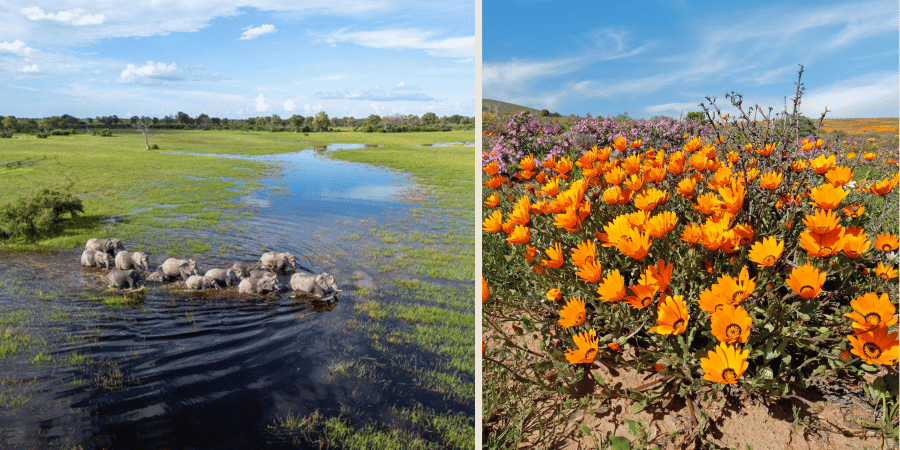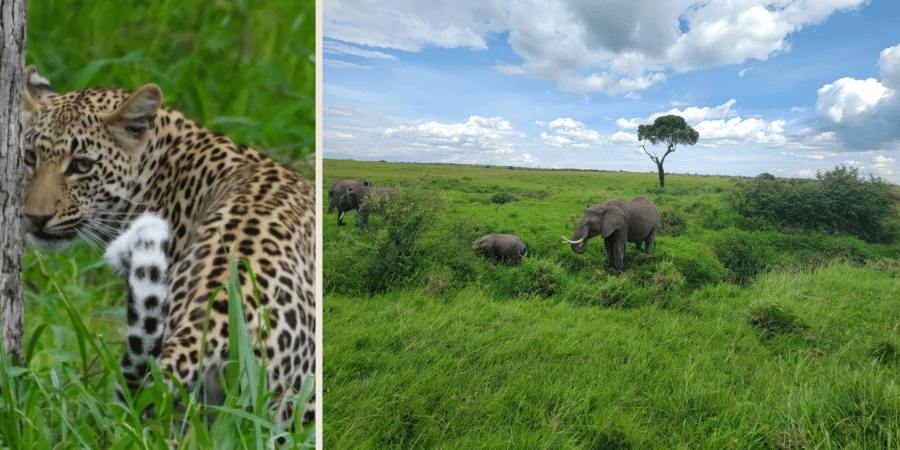It’s no secret that green season is one of my favorite times to go on safari. The fresh rains renewing the land, the birth of new animals, the brilliant colors of all the birds, and of course the land bursting with color from green grass to technicolored wildflowers.
Somehow though, green season safaris are booked significantly less than dry season trips. And I think it’s simply because most people don’t know about them—or worse, they’ve been told it’s “off-season” and assume that means it’s second-rate.
Let me set the record straight: green season isn’t off-season. It’s a different season, with its own remarkable advantages that some travelers (myself included) actually prefer.

What is the Green Season?
Green season refers to the months when rain comes to Africa—typically November through April, though timing varies by region. These are the wet months, when the landscape transforms from the golden-brown tones of the dry season into vibrant, lush green.
Most safari-goers book during dry season (June-October) because that’s when wildlife is easiest to spot—animals congregate around limited water sources, making sightings more predictable and concentrated. It’s spectacular, and I recommend it for many first-time safari travelers.
But green season offers something different: a more intimate and dramatic African experience.
Advantages of Green Season Safaris
Calving Season – The green season is also calving season for many African animals. Wildebeest, zebra, antelope, and other species time their births to coincide with the rains when food is plentiful.
What does this mean for you? You’ll get to watch baby animals take their first steps. And get to follow the predators which are never far behind breeding herds. This is a moment you simply won’t see during dry season.
Dramatic Landscapes and Photography – If you’ve seen safari photos, you’ve probably noticed they often look quite brown—golden grass, dusty roads, muted tones. That’s dry season. Green season is the opposite: vibrant emerald grass, wildflowers carpeting the ground in purples, yellows, and reds, trees heavy with new leaves. The landscape is alive with color.
And then there are the storms. Massive cloud formations build through the afternoon, creating the most dramatic skies you’ll ever photograph. When the sun breaks through just before sunset, the light is golden and magical. Storm clouds on the horizon, lightning in the distance, rainbows arching across the savanna—this is green season.
For photographers, green season can actually be superior to dry season because of the lighting, colors, and lack of dust in the air.
Far Fewer Crowds – During peak dry season, popular parks can get crowded. When a leopard is spotted, word spreads on the radio and suddenly there are 10-15 vehicles surrounding the sighting. It’s still amazing, but it’s also a bit of a traffic jam.
In green season, there might be half as many tourists—or fewer. When you find that leopard, you might be the only vehicle there. You can watch without the pressure of other people waiting for their turn, without other tourists chattering in the background of your experience.
The lodges are also less crowded, which means more personalized attention from staff and guides, more flexibility with activities and meals, and a more intimate overall experience.
Significantly Lower Rates – Same tents, same beds, same food, same guides, same service—just lower prices because it’s not peak demand season.
For many travelers, this is what makes luxury safari accessible. The high-end lodge that was out of reach during peak season? Suddenly it fits your budget during green season. Or you can extend your trip—turn seven nights into ten for the same money.
Exceptional Birding – If you’re a birder, this isn’t even a choice—green season is when you go.
Migratory birds arrive from Europe and elsewhere, joining Africa’s resident species. Birds are in their breeding plumage, showing off their most vibrant colors. Nesting activity means you can observe behaviors you won’t see during other times.
Even if you’re not specifically a birder, the sheer variety and color of birds during green season adds another dimension to your safari experience.

Addressing concerns
What About the Rain?
The most common concern I hear about green season is: “Won’t it rain constantly?”
Let me explain what green season rain actually looks like. It doesn’t rain all day, every day. The typical pattern is:
- Clear, beautiful mornings (perfect for game drives)
- Warm, pleasant afternoons
- Late afternoon thunderstorms (usually 1-3 hours)
- Clear evenings
Morning game drives—which are often the best for wildlife viewing anyway—are almost always dry. By the time the afternoon storms roll in, you’re typically back at the lodge for lunch and a rest anyway.
And honestly? Watching a thunderstorm roll across the African savanna is spectacular. The build-up of clouds, the first drops hitting the dusty earth, the smell of rain on dry ground, the dramatic lighting—it’s an experience, not an inconvenience.
That said, be prepared: you might get wet. You might have a game drive cut short by rain. A few roads might be muddy. If the idea of any rain stresses you out, then dry season is probably better for you. But if you can embrace it as part of the experience, it adds rather than detracts.
Is the wildlife viewing worse?
It’s different, not worse.
During dry season, animals concentrate around limited water sources. This makes them predictable and easy to find. You’ll see lots of animals in relatively small areas.
During green season, water is everywhere, so animals disperse across the landscape. You might drive longer distances between sightings. You won’t see 50 elephants at a single waterhole because they don’t need to congregate—they can drink anywhere.
But here’s what you gain: more intimate encounters. When you do find wildlife, you’re often alone with them. No competition with other vehicles. Just you, your guide, and the animals.
You also see different behaviors. Animals are more relaxed when not stressed by heat and drought. Predators are actively hunting because prey has dispersed. Territorial displays happen during mating season.
For first-time safari-goers who want to see lots of animals reliably, I usually recommend dry season. But for return visitors, photographers, or anyone who values quality of encounter over quantity of sightings, green season is wonderful.

Where and When to Go
Green season timing varies by destination:
Botswana (December-March) This is when the Okavango Delta reaches full flood—an incredible sight. The entire system of channels and lagoons expands, creating a water wonderland. Game viewing remains excellent, and you get both water-based activities (mokoro canoes) and land-based game drives. The contrast of green islands and blue water is stunning.
Tanzania (November-December, March-May) January and February bring the calving season in the southern Serengeti—thousands of wildebeest giving birth over just a few weeks. The predator action is intense as lions and cheetahs feast on vulnerable young. This is one of nature’s great spectacles, and it only happens during green season.
Kenya (November-December, March-May) The Masai Mara is lush and green, with excellent wildlife viewing but far fewer tourists than during the migration months. The Great Rift Valley lakes are full, and birding is exceptional throughout the country.
South Africa (November-March) This is actually summer in South Africa, meaning warm, pleasant weather for game drives. Kruger National Park and the private reserves are less crowded, baby animals are being born, and the vegetation is lush. This is one of the easiest green season destinations because infrastructure is excellent.
Zambia (November-April) South Luangwa is gorgeous when green, and Lower Zambezi offers excellent game viewing throughout. But the real star is Victoria Falls, which reaches its most powerful flow between February and May. If you want to see the Falls at their most impressive—a wall of water so massive it creates its own weather system—green season is essential.
Zimbabwe (November-March) Like Zambia, Zimbabwe offers Victoria Falls at full power during green season. Hwange National Park is dramatic with afternoon storms rolling across the landscape, and Mana Pools remains one of Africa’s most beautiful parks when lush and green.

Making the Choice
I’m not here to tell you that green season is better than dry season—they’re just different, and the right choice depends on what you value most.
If you want guaranteed, concentrated wildlife viewing and don’t mind crowds or brown landscapes, dry season is wonderful. If you want dramatic scenery, baby animals, intimate encounters, and better value, green season might actually be your perfect safari.
The key is knowing these options exist and making an informed choice rather than defaulting to dry season just because that’s what everyone books.
I’ve done safaris in both seasons, and I keep returning to green season because I love the drama, the color, the sense of renewal, and yes, the solitude. There’s something special about having the African wilderness feel a bit more yours, with fewer reminders of the tourism infrastructure.
But that’s me. What matters is what you want from your African adventure.
Let’s Talk About Your Safari
Whether you’re drawn to the lush drama of green season or the concentrated wildlife of dry season, I’d love to help you plan your perfect African adventure. We can discuss timing, destinations, your priorities and concerns, and create an itinerary that matches what you’re hoping to experience.
Green season bookings often have shorter lead times, which means if you’re flexible on dates, we can sometimes pull together an incredible trip on a timeline that wouldn’t work during peak season.
Ready to explore green season safari options? Contact our team to discuss your travel dates and what kind of African experience you’re dreaming of.

